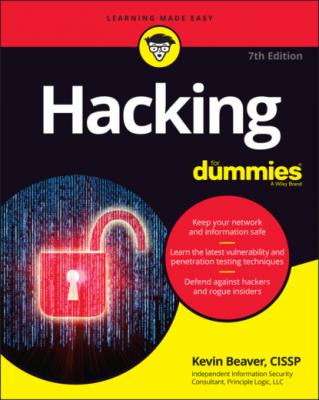Hacking For Dummies. Kevin Beaver
Читать онлайн.| Название | Hacking For Dummies |
|---|---|
| Автор произведения | Kevin Beaver |
| Жанр | Зарубежная компьютерная литература |
| Серия | |
| Издательство | Зарубежная компьютерная литература |
| Год выпуска | 0 |
| isbn | 9781119872214 |
Related international laws —such as the Canadian Personal Information Protection and Electronic Documents Act (PIPEDA), the European Union’s General Data Protection Regulation (GDPR), and Japan’s Personal Information Protection Act (JPIPA) — are no different. Incorporating your security tests into these compliance requirements is a great way to meet state and federal regulations and to beef up your overall information security and privacy program.
Understanding the Need to Hack Your Own Systems
To catch a thief, you must think like a thief. That adage is the basis of vulnerability and penetration testing. Knowing your enemy is critical. The law of averages works against security. With the increased number of hackers and their expanding knowledge and the growing number of system vulnerabilities and other unknowns, all computer systems and applications are likely to be hacked or compromised somehow. Protecting your systems from the bad guys —not just addressing general security best practices — is critical. When you know hacker tricks, you find out how vulnerable your systems really are and can take the necessary steps to make them secure.
Hacking preys on weak security practices and both disclosed and undisclosed vulnerabilities. More and more research, such as the annual Verizon Data Breach Investigations Report (www.verizon.com/business/resources/reports/dbir/), shows that long-standing, known vulnerabilities are continually being targeted. Firewalls, advanced endpoint security, security incident and event management (SIEM), and other fancy (and expensive) security technologies often create a false feeling of safety. Attacking your own systems to discover vulnerabilities — especially the low-hanging fruit that gets so many people into trouble — helps you go beyond security products to make them even more secure. Vulnerability and penetration testing is a proven method for greatly hardening your systems from attack. If you don’t identify weaknesses, it’s only a matter of time before the vulnerabilities are exploited.
As hackers expand their knowledge, so should you. You must think like them and work like them to protect your systems from them. As a security professional, you must know the activities that the bad guys carry out, as well as how to stop their efforts. Knowing what to look for and how to use that information helps you thwart their efforts.
Anticipating all the possible vulnerabilities you’ll have in your systems and business processes is impossible. You certainly can’t plan for all types of attacks — especially the unknown ones. But the more combinations you try and the more often you test whole systems instead of individual units, the better your chances are of discovering vulnerabilities that affect your information systems in their entirety.
Don’t take your security testing too far, though; hardening your systems from unlikely (or even less likely) attacks makes little sense and will probably get in the way of doing business.
Prioritize your systems so that you can focus your efforts on what matters.
Test your systems in a nondestructive fashion.
Enumerate vulnerabilities and, if necessary, prove to management that business risks exist.
Apply results to address the vulnerabilities and better secure your systems.
Understanding the Dangers Your Systems Face
It’s one thing to know generally that your systems are under fire from hackers around the world and malicious users around the office; it’s another to understand specific potential attacks against your systems. This section discusses some well-known attacks but is by no means a comprehensive listing.
Many security vulnerabilities aren’t critical by themselves, but exploiting several vulnerabilities at the same time can take its toll on a system or network environment. A default Windows operating system (OS) configuration, a weak SQL Server administrator password, or a mission-critical workstation running on a wireless network may not be a major security concern by itself. But someone who exploits all three of these vulnerabilities simultaneously could enable unauthorized remote access and disclose sensitive information (among other things).
Vulnerabilities and attacks have grown enormously in recent years because of virtualization, cloud computing, and even social media. These three things alone add immeasurable complexity to your environment. On top of that, with the new ways of the world and so many people working from home, the complexities have grown exponentially.
Nontechnical attacks
Exploits that involve manipulating people — your users and even you — are often the greatest vulnerability. Humans are trusting by nature, which can lead to social engineering exploits. Social engineering is exploiting the trusting nature of human beings to gain information — often via email phishing — for malicious purposes. With dramatic increases in the size of the remote workforce, social engineering has become an even greater threat, especially with more personal devices being used that are likely much less secure. Check out Chapter 6 for more information about social engineering and how to guard your systems and users against it.
Other common, effective attacks against information systems are physical. Hackers break into buildings, computer rooms, or other areas that contain critical information or property to steal computers, servers, and other valuable equipment. Physical attacks can also include dumpster diving — rummaging through trash cans and bins for intellectual property, passwords, network diagrams, and other information.
Network infrastructure attacks
Attacks on network infrastructures can be easy to accomplish because many networks can be reached from anywhere in the world via the Internet. Examples of network infrastructure attacks include the following:
Connecting to a network through an unsecured wireless access point attached behind a firewall
Exploiting weaknesses in network protocols, such as File Transfer Protocol (FTP) and Secure Sockets Layer (SSL)
Flooding a network with too many requests, creating denial of service (DoS) for legitimate requests
Installing a network analyzer on a network segment and capturing packets that travel across it, revealing confidential information in cleartext
Operating system attacks
Hacking
